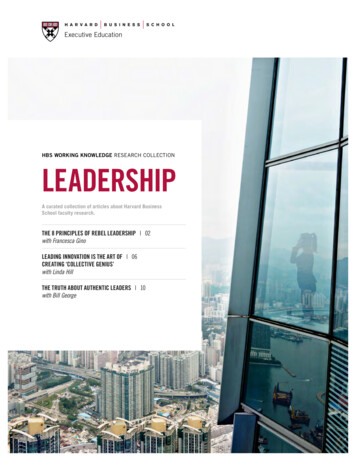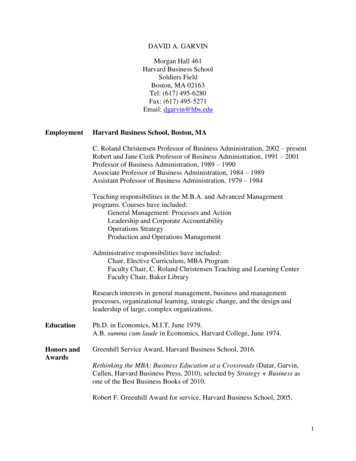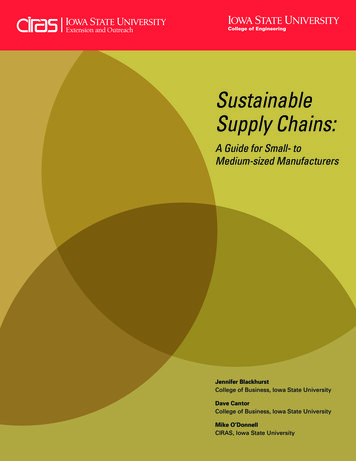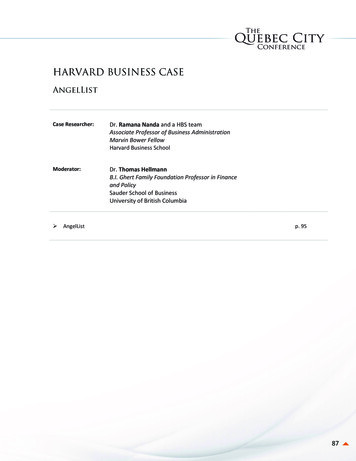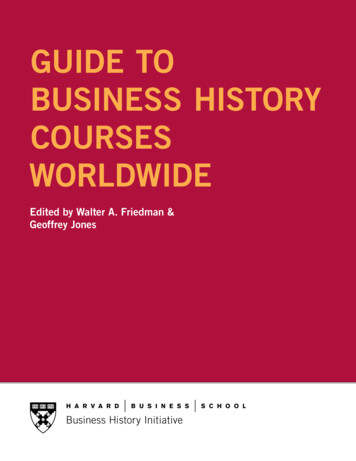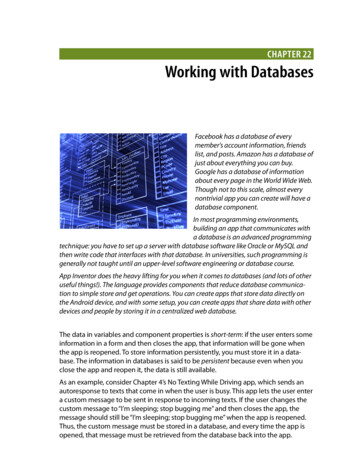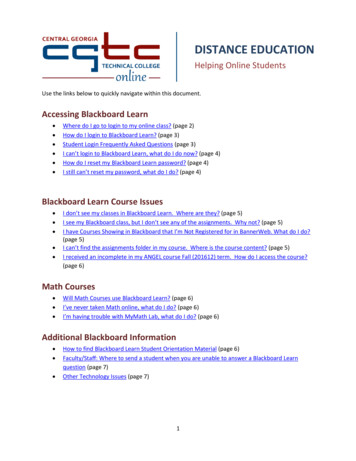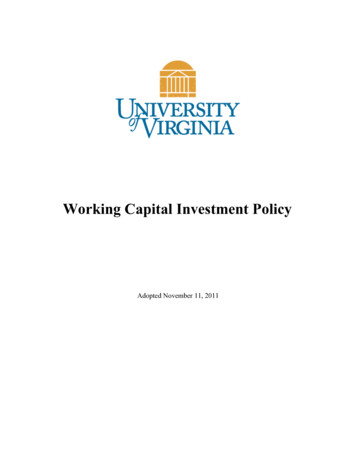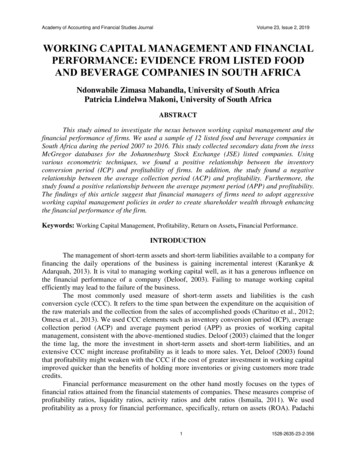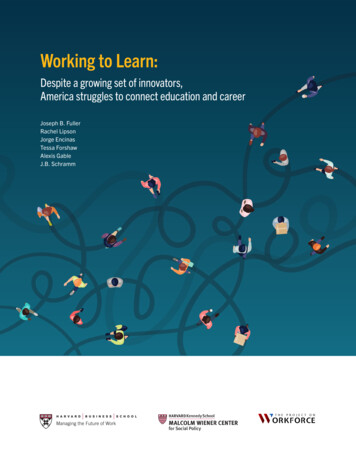
Transcription
Working to Learn:Despite a growing set of innovators,America struggles to connect education and careerJoseph B. FullerRachel LipsonJorge EncinasTessa ForshawAlexis GableJ.B. Schramm
About the authorsJoseph B. Fuller is a Professor of Management Practice at Harvard Business School. He co-chairs theHBS Project on Managing the Future of Work and the Project on Workforce at Harvard. He is a visitingfellow at the American Enterprise Institute.Rachel Lipson is the Director of the Project on Workforce at Harvard. She is based at the Malcolm WienerCenter for Social Policy at the Harvard Kennedy School.Jorge Encinas is a PhD candidate at the Harvard Graduate School of Arts and Sciences.Tessa Forshaw is a PhD candidate at the Harvard Graduate School of Arts and Sciences. She is also amember of the teaching faculty at the Stanford University d.school and Harvard University ExtensionSchool.Alexis Gable is a PhD candidate at the Harvard Graduate School of Arts and Sciences.J.B. Schramm is Founder and Managing Partner of Grove Social Impact Partners. Formerly hefounded College Summit (now PeerForward) and New Profit’s Learn to Earn fund, the incubator of thePostsecondary Innovation for Equity (PIE) initiative.AcknowledgmentsThe Project on Workforce and the HBS Project on Managing the Future of Work benefitted significantlyfrom New Profit’s expertise and experience with the PIE Initiative. New Profit supported both the designand publication of the white paper.The authors would like to give a special thanks to New Profit’s Bill Jackson, Entrepreneur-in-Residenceand Glendean Hamilton Stewart, Associate Partner for their key contributions.The views expressed in this paper are the authors’ sole responsibility and not meant to represent theviews of Harvard Business School, Harvard Kennedy School, Harvard University, or New Profit.Please direct inquiries to: Rachel Lipson (rachel lipson@hks.harvard.edu)Suggested citation: Fuller, J., Lipson, R., Encinas, J., et al (March 2021). Working to Learn: Despite agrowing set of innovators, America struggles to connect education and career. Published by the Projecton Workforce at the Malcolm Wiener Center for Social Policy at the Harvard Kennedy School and theHarvard Business School Managing the Future of Work Project.Report design: Terberg Design LLC
Executive summary2The Landscape6Overview: Who are the innovatorsin the education-and-employment sector?9Structural characteristics11Taxonomy of the education-and-employment sector23Conclusion27Appendix29WORKING TO LEARN1
Executive summaryContext: An expanding field,but not at full potentialAs the structure and makeup of theAmerican workforce shift, the educationand training system has lagged behind therate of economic change. Yet, there is aclear appetite among learners, workers,employers, and funders for new models ofworking and learning. The demand for newmodels has only accelerated during theCOVID-19 pandemic, as Americans indicate more interest in pursuing non-degreeoptions amid economic uncertainty andsocial distancing.1 As a result, organizationsthat train individuals for jobs are expanding,adapting, and attracting new attention.We call this growing set of for-profit, non-profit, andpublic programs the “education-and-employmentsector.” We use this term to be intentionally inclusive of organizations that straddle both the postsecondary education and employment sectors. Manyof these new models are emerging from the world ofstart-ups and social entrepreneurship. These organizations often sit outside the confines of traditionalK-12 and higher education systems, and therefore,have proven difficult for education data sources tocapture. Though they employ diverse approaches,they share a common goal: to help more Americansachieve economic success through a combination ofeducational attainment and work experience.In October 2019, New Profit, a venture philanthropy organization, announced a new initiative,Postsecondary Innovation for Equity (PIE). PIE wasdesigned to support innovative organizations thatare helping young people access “postsecondaryeducation and work experience needed to accessupwardly mobile careers.” Through an open application process, 316 organizations applied for unrestricted grants of 100,000 and capacity buildingsupport. 20 organizations were ultimately selectedas winners.2These 316 applications serve as the primary datasource for this report. Though self-selected and selfreported, the data from the applicant pool providesa richly detailed profile of organizations seekingto connect learners with employment. The datacontains descriptive information for each organization, such as headquarters location, year founded,learners served, revenue, expenses, and staffing. Inaddition, PIE asked applicants to describe variousorganizational characteristics in more detail. Thisincluded their program model, outcomes measurement, objective in participating in the PIE initiative, and how they implement diversity, equity, andinclusion.While the dataset has some limitations, it providesvaluable insight into a growing field. In 2019, theapplicant organizations collectively served over2.6 million learners and generated over 4.1billion in revenue. Over half of the organizations inthe dataset were formed in the prior decade andapproximately 25 percent in the last five years. Theywere also expanding quickly. The average organization had a 31 percent average compound annualgrowth rate in learners served in 2019. Nearly halfof the organizations planned a site expansion in thecoming year.Our analysis employs both quantitative and qualitative measures to better understand this growingsector. We examined the structural characteristics(e.g. organizational size and reach, age and growth,funding sources) as well as program models anddelivery approaches, leadership, and programoutcomes. Key data points from our analysis aresummarized in the box below. Looking across theorganizations represented in this dataset, we drawthree broad takeaways.1. Despite a focus on innovation,approaches are slow to changeThe PIE competition featured “innovation” in itsname and specifically called for social entrepreneurs to apply. Organizations in the applicantset touted their models as cutting-edge. Yet, our
analysis found that their models still primarilyoperate within the confines of traditional K-12and higher education practices. Adapting to thechanging nature of work did not appear to be aprimary focus across the field.First, delivery forms largely did not leverage technology. Before the onset of the COVID-19 pandemic,the field was heavily skewed towards in-personmodels. Only six percent of programs were fullyonline; 11 percent had hybrid models.In addition, the sector maintains a college vs. careerdichotomy, rather than prioritizing both educationaland employment outcomes. We found that organizations that worked with educational institutions likehigh schools or colleges were unlikely to collaboratewith employers. Success measurement was similarlysiloed between education and employment metrics.Finally, organizations in the dataset are primarilyyouth-serving. The PIE application stipulated thatNew Profit was seeking applicants that servedprimarily but not only 15 to 30-year-olds. It isinteresting nonetheless that many organizationsappear to serve a young population exclusively. Fewprograms include older workers who may need toreskill in their target population. Less than onequarter of organizations in our dataset primarilyserved individuals outside the 16-30 age cohort,with 58 percent serving a population with at least80 percent of learners aged 16-30.2. While effective models exist, provensuccess factors are missing from manyprogramsAfter two decades of program evaluations andcausal studies in the field, there is increasing understanding of program models that lead to sustainedearnings and employment gains. Among other characteristics, programs with strong evaluation resultsfeature sectoral focus and robust employer relationships, both occupational and soft skills training, andthe provision of wraparound services.2 Yet despitethe growing base of evidence, our research foundthat such proven practices still have relatively littlepenetration across the field at large. Only about onethird (35 percent) mentioned that they were workingdirectly with employers. Only about one-quartermentioned providing learning opportunities in workplace environments. Just nine percent of organizations emphasize both job-specific and foundationalsoft skills. Meanwhile, 13 percent of organizationssaid they directly provided wraparound services,like housing support, living stipends, mental healthservices, or transportation subsidies.One explanation could be the perceived cost ofproviding such services. Many applicants notedanecdotally the operational challenges of workingwith employers, teaching soft skills, providing wraparound services, or monitoring outcomes. However,we found no statistical relationship between anyof these characteristics and estimates of cost-perlearner. In fact, there was a statistically significant, positive relationship between the programsthat involved employers and growth in learners.Programs that involved employers tended to havehigher learner growth rates. When coupled with theevaluation literature, our findings suggest that manyorganizations should reconsider resource allocationand program delivery priorities.3. The broader evidence base is still nascent,and scale has been difficult to achieveWhile some education-and-employment programscould provide evidence of efficacy through independent evaluations or quasi-experimental researchdesigns, our research revealed that most playerscould not meet high evidentiary standards. Themost common success metric tracked by organizations was whether participants completed theprogram offered by the applicant. In contrast, therewas relatively little understanding of impact onlong-term employment or educational outcomes.For instance, less than three percent of organizations tracked long-run career progression, and noneof the 316 measured learning. Only nine percent ofapplicants cited an existing study, quasi-study, orexternal evaluation of the program model in theirapplication. Nearly a third of organizations cited theneed to enhance their data and evaluation capabilities as a motivation for seeking funds. Based on thissample, our findings indicate the education-andemployment field needs to invest in evidence if it isto increase its impact for the 71 million Americanswith a high school diploma but without a bachelor’sdegree.3WORKING TO LEARN3
Perhaps it is not surprising then, that this alsoremains a relatively fragmented field, whereindividual organizations struggle to scale theirprograms. The median organization served a fewhundred learners each year. One-quarter of thedataset served 135 or fewer learners. Connectedto scale, the sector also remains reliant mainly onphilanthropic funding. The median organizationexpected 60 percent of 2019 revenue to come fromphilanthropy. Significant public funding sourceswere cited by just five percent of organizations,posing questions about long-term sustainability.Implications: Education and employmentmatter for the future of opportunityThe correlation between race and educationalattainment in the US provides an important backdrop for our work. In 2019, only 26 percent of BlackAmericans and 19 percent of Hispanic Americansages 25 and older held a bachelor’s degree,compared to 40 percent of white Americans.4Degree attainment has been slowly rising, andclosing the racial gap on college access and attainment remains a critical national priority. In theinterim, however, short-term training programs oftenprovide more accessible pathways to economicopportunity. Prior research finds that low-incomestudents and students of color are more likelyto enroll in two-year institutions and certificateprograms.5 In our analysis, we see similar patterns.For instance, we find that over 40 percent of organizations focused on job-specific training are workingexclusively with low-income youth and youth of color.Fortunately, the leadership of this sector appearsmore representative than many institutions ofpower in American society. Over 40 percent of theapplicants to PIE that chose to respond identifiedas members or former members of the population that their organization served, and 40 percentself-identified as Black or Hispanic/Latinx. Overone-third of the leaders self-identified as Pell Grantrecipients; and over one-third were first generationcollege attendees themselves. Still, the disproportionate share of Black and brown Americans servedby education-and-employment organizations pointsto the important role these institutions can playin reducing inter-generational racial inequality inAmerica.4Finally, the sector also confronts a great opportunity. Smaller organizational footprints and privateand philanthropic funding often mean greater flexibility. These organizations could be at the forefrontof reshaping how the American educational systemprepares learners for the future of work. Already,a small set of innovators are demonstrating theimpact of melding occupational and transferableskills and creating strong models for “learning bydoing.” The future of mobility and opportunity maywell depend on their capacity to influence others.Indeed, success may not ultimately mean the innovators scale on their own. If they can provoke largeincumbent institutions to prioritize both educationand career, they will leave a lasting mark.
Top Ten Insights from the Education-and-Employment Sector Dataset:Program Design and Delivery ModelsTheories of Change and Measures of Evidence1.83% of programs were offered fully in person(pre-COVID).7.2.Less than 9% of programs emphasize both jobspecific and foundational skills.Nearly half of the leaders and founders do whatthey do because they or their family memberswere/are members of the
Working to Learn: Despite a growing set of innovators, America struggles to connect education and career. Published by the Project on Workforce at the Malcolm Wiener Center for Social Policy at the Harvard Kennedy School and the Harvard Business School Managing the Future of Work Project. Report design: Terberg Design LLC
